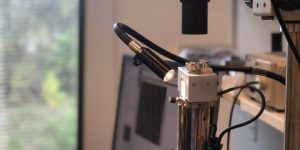
Tau is a microtubule associated protein that is implicated in a host of neurodegenerative disorders, including Alzheimer’s, parkinsonism linked to chromosome 17, and chronic traumatic encephalopathy (CTE). My recent work has focused on understanding the properties of this protein, using an atomic force microscopy assay to study specific domains of immobilized proteins on solid supports.
- Dimerization and Long Range Repulsion Established by Both Terminals of the Microtubule Associate Protein Tau, Z. J. Donhauser, J. Saunders*, D. D’Urso*, and T. A. Garrett, Biochemistry 56, 5900 (2017).
Microtubules are cylindrical polymers of the protein tubulin that play a number of essential roles in eukaryotic cells. In my initial work at Vassar College, I used atomic force microscopy to study the nanoscale structure and mechanics of microtubules. Complementing our studies of microtubules, we have also investigated Zn-induced tubulin sheets as a model system for the study of tubulin and protofilament structure.
- Enhanced Mechanical Stability of Microtubules Polymerized with a Slowly Hydrolyzable Nucleotide Analogue, K. M. Munson*, P. G. Mulugeta*, and Z. J. Donhauser, Journal of Physical Chemistry B 111, 5053 (2007).
- Mechanics of Microtubules: Effects of Protofilament Orientation, Z. J. Donhauser, W. B. Jobs*, and E. C. Binka*, Biophysical Journal 99, 1668 (2010).
- Structural Changes in Tubulin Sheets Caused by Immobilization on Solid Supports, Z. J. Donhauser, V. Appadoo*, E. J. Kliman*, W. B. Jobs*, and E. C. Sheffield*, ACS Omega 3, 18196 (2018).
I love getting my students involved in my research research projects. Every year, I mentor new students in my lab, and I endeavor to bring my research into the classroom. In one example, I developed a laboratory module for undergraduate chemistry courses that uses biomimetic surfaces to introduce students to principles of surface chemistry and materials science.
- A novel general chemistry laboratory: creation of biomimetic superhydrophobic surfaces through replica molding, S. Verbanic*, O. Brady*, A. Sanda*, C. Gustafsen*, Z. J. Donhauser, Journal of Chemical Education 91, 1477 (2014).
.